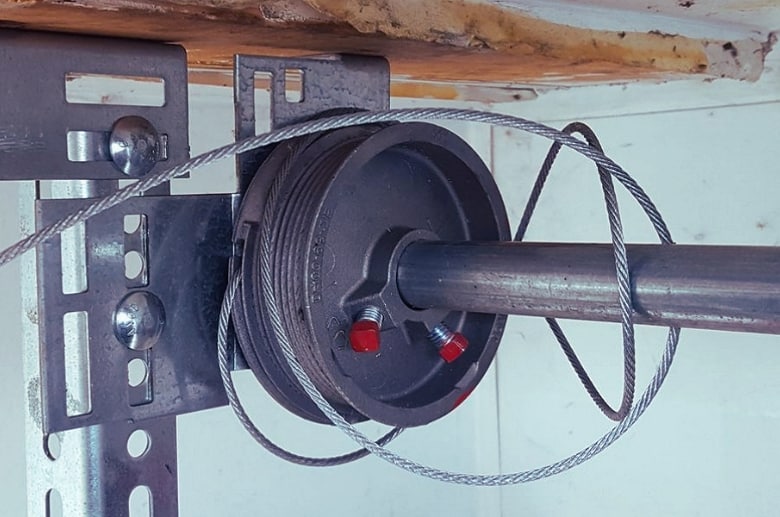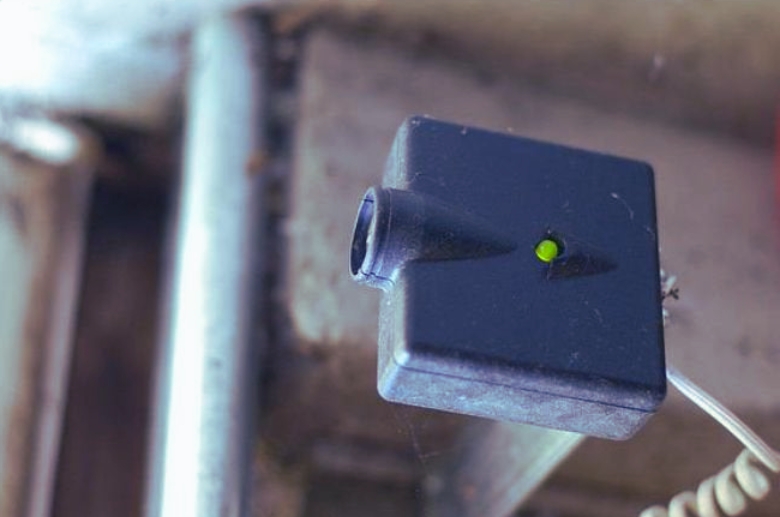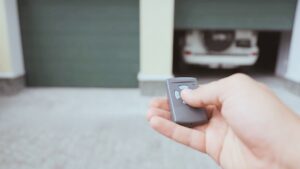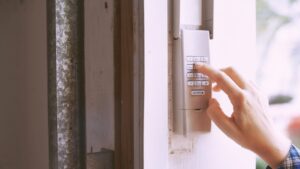As a homeowner, it can be frustrating when your garage door only opens a few inches, making it difficult to get your car in and out.
This is just one of several common garage door problems that can often be resolved quickly. In this article, we’ll discuss the most common reasons for causing this issue and provide practical solutions to help you resolve the problem.
If you’re tired of struggling with your garage door and want it to work correctly again, keep reading to learn more.
Common Reasons Why Your Garage Door Only Opens A Few Inches
What can cause your garage door to open a few inches or reverse? We point out all the possible causes and fixes below.
1. Broken or Defective Springs

One of the most common reasons why your garage door only opens a few inches is due to broken, damaged, or defective springs.
Typically, springs are responsible for counterbalancing the garage door’s weight, allowing it to open and close smoothly.
The springs tighten and unwind upon closing and opening, respectively. This means that when a door opens, the spring releases its tension and eases the uplifting process. Therefore, the garage door won’t open if the spring is damaged, broken, or defective.
To determine if the spring is broken:
- Look for a metal shaft above the door for where the torsion spring located
- If there is a split in it, you have a broken spring
Garage Insider Tip: If a spring is broken, we recommend you stop operating the door until you fix it. The best action is to call a technician to look at it because continued use can result in a damaged opener and costlier repairs.
However, if the spring is not broken, look for the following signs:
- The springs look overly stretched or rusty
- The door opens and close with snapping noises
How to Fix
Fixing broken garage door springs can be dangerous and challenging, and it’s best to leave it to the professionals. Here are some reasons why:
- Garage door springs are under a lot of tension and can cause severe injury or even death if they snap or come loose because they are tightly wound.
- Professionals have the knowledge, skills, and tools to safely replace or repair garage door springs.
- Attempting to fix broken garage door springs on your own can lead to further damage or even more costly repairs.
- Professionals can quickly diagnose the problem and recommend the best solution based on your garage door and spring type.
- Hiring a professional can give you peace of mind knowing they will fix your garage door properly and safely.
In summary, fixing broken garage door springs can be a dangerous and complicated process that is best left to experienced professionals to avoid injury and ensure proper repair.
2. Loose or Damaged Pulleys and Cables

Cables and pulleys make up the moving system of a garage door and are located on each side of the door’s top side. They help lift and move the door along the track, meaning if they are damaged or loose, the door’s operation won’t be smooth.
Knowing the three types of cables that garage doors have will help you diagnose the problems when they arise.
- Safety cables. They prevent damages or injuries when the door’s extension spring fails.
- Lifting cables. These are the most common, connecting the door to the springs for raising functionality.
- Emergency release cables. These are used to open doors during motor failure or power outages.
Regardless of the cable type, they all face common issues, and you might realize the garage door opens a little and then stops.
Some of the issues that cause cable and pulley problems include:
- Snapping
- Freezing
- Becoming loose
How to Fix
Fixing cables and pulleys is easy, but you must first narrow down the problem. Start by inspecting the cables and pulleys for any visible damage or obstructions, such as debris or rust. Other signs to look out for include a visible cable sag or a grinding or scraping noise when the door is in motion.
- If it’s loose, tighten the pulley,
- If damaged, replace it.
- If it’s during the cold season and everything else seems okay, yet the door opens a little, freezing might be the cause. Thus we recommend you use a lubricant.
Connect With A Garage Expert
Connect with local experts, Compare quotes, Get the best price.
3. Opener Problems

A garage door opener is a crucial component, and its settings may be why a garage door only opens a few inches. The opener is a motorized component that drives the garage door and consists of a power unit with an electric motor attached to a track.
It also has a trolley connected to an arm attached to the door’s top, which slides back and forth, helping the closing and opening mechanism.
Some of the problems leading to the opener not operating as expected include the following:
- Power issues. This can be due to a disconnection or an overheated, flipped, or burnt Ground-Fault Circuit Interrupter (GFCI)
- Burnt motor
- If you are out of the garage door’s antenna
- Broken gear sprocket
But if everything else is fine, the problem may be the opener force setting, which is the adjustable power required to open or close the door. So, if there is any problem, the door will not open or close as expected.
How to Fix
Adjust the power setting by following these steps:
- To raise the upward travel, locate the white-colored up limit adjustment screw and rotate it clockwise. If you wish to reduce this, spin counterclockwise instead. You can find these knobs on your track or opener for easy access and accuracy.
- Find the downward movement adjustment screw for the downward motion and turn it counterclockwise to increase down travel. Again, turn it clockwise to increase its motion.
Before adjusting the power setting, make sure you try the following options:
- Ensure the motor unit’s antenna is not damaged. Alternatively, ensure it hangs downward. This is a quick way to ensure nothing is blocking the opener signal.
- Ensure the remote batteries are working and the wall switch is connected to the power and in good working condition.
If all these options do not fix the problem, check the issues with the opener settings and adjust accordingly.
4. Safety Sensors Malfunctions

Garage door sensors are small black boxes with indicator lights located on both sides of the door. Their primary function is to create an invisible tripwire by transforming electricity into an infrared light beam. With this transformation, they can detect any obstructions in the door’s path and prevent it from closing or opening.
Ideally, they are a safety measure, preventing the door from closing and causing injury.
The most common problems with sensors are:
- Misalignment
- Damage
- Obstruction
Connect With A Garage Expert
Connect with local experts, Compare quotes, Get the best price.
How to Fix
The easiest way is to inspect the sensors for visible damage or obstructions, such as dirt, debris, or misalignment. First, check for dirt on the sensor lens because the garage is prone to dirt. If you find any, clean it with a soft cloth dipped in soapy water.
If there is no visible dirt or damage, adjust the sensors by:
- Loosening the screws on the pivotal bracket
- Aligning both sensors with each other
- Testing the sensors by placing a soft object under the door to see if it is detected. If not detected, and the door closes and crashes, you need to call a professional ASAP!
On the other hand, if the sensors are damaged, you may need to replace them or consult a garage door technician.
5. Logic Board

The logic board is the “brain” of your garage door opener, responsible for controlling the various components of the system. It signals your remote or the keyless entry for the smooth running of the garage door.
If the logic board malfunctions, it may not send the correct signals to your garage door opener. This means the garage door only opens a foot or struggles to open. And even if you are not a tech-savvy individual, there are some things to look out for to determine if the problem is in the logic board.
Some of these tell-tale signs include:
- LEDs on the sensors are not lit or blinking
- The door opener appears to have no power despite being connected
- The opener is not working as expected. Such as opening a different door
- Remote does not work even after replacing the batteries
- The photo eyes do not have power despite being plugged in
- The warning light does not shine constantly or is flashing
How to Fix
A logic board consists of different components, and it is recommended to have a professional look at it. This is important as it will prevent damage or the risk of electric shock.
Nevertheless, a technician will follow these steps to fix the problem:
- Disconnect the garage door opener to prevent damage or injury due to electric shock
- Open the plastic cover and inspect the circuit board
- Take out the old board if they determine you need a new one
- Install a new board
- Test the working of the new board
- Close and reattach the board
6. Battery in Your Garage Door Remote

Sometimes your garage door may open a few inches because of weak or dead remote batteries. These batteries will not power your remote to send the correct signals to your garage door opener, causing it to stop or only open a few inches. Some signs of a weak battery include a dim or non-functional light on the remote or an inability to operate the door.
Another option to determine if the batteries are dead is to use the wall switch or keypad to open or close the door. If it functions, it may point to remote battery problems.
How to Fix
After testing and ascertaining the problem is the batteries, fix the issue through the following:
- Remove the battery and check if they are placed correctly
- Recharge the batteries and test opening or closing the door
- Use another compatible set of batteries and test
- If these do not resolve the issue, have a technician look at the remote
Connect With A Garage Expert
Connect with local experts, Compare quotes, Get the best price.
7. Electrical Power Issues
Your garage door’s electrical power system is another common reason why your garage door may only open a few inches before stopping. If there are any issues with the system, the power gets disrupted; thus, the door fails to open fully.
Additionally, the system consists of a remote control, wall switch, and opener. The remote control is a transmitter, while the opener has a receiver. When you press the remote, a radio wave is created, which the receiver picks and closes or opens the door as needed.
On the other hand, the quick-release mechanism allows for manual operation during a power outage. This power unit is usually located above the garage door towards the rear.
Some of the issues to look out for include the following:
- Ensure that the power source is connected and functioning correctly
- Check the power cord, outlet, and circuit breaker to ensure they work correctly
To determine if the problem is electrically-related, look at the inability to operate the door or a malfunctioning opener.
How to Fix
Electrical malfunctioning is easy to diagnose and fix, unlike most other causes. The first step is checking if the power cord is connected.
But if you are not well-versed in the electrical system, consult a professional electrician or garage door technician.
8. Misaligned Door Tracks

The tracks on either side and top of your garage door provide pathways that ensure a safe, soundless, uniform opening or closing. These tracks guide the door during its movement so that you can enjoy smooth functioning without any hassles.
But like any other door part, the tracks suffer different issues, which affect the smooth running of the door. Some of the problems you will encounter with the tracks include:
- Dirt or sand on the track will cause stuttering, popping, or screeching noises when opening or closing the door.
- Loose or damaged track causing partial door opening, binding, or rubbing against the molding.
- A gap between the track and the rollers
- Warped or misaligned tracks which jam the rollers
How to Fix
Typically, tracks are not lubricated but are instead cleaned. So, the best way to fix the problem is by:
- Inspecting the track for any dirt or debris
- Clearing out any debris found
- Clean with a piece of cloth dipped in soapy water, and if necessary, use a grease cleaner
- Call a professional if the tracks are warped or misaligned and need a repair or replacement.
However, if you are looking for a well-guided DIY fix to solving the binding problem, follow these steps:
- Using a screwdriver, loosen the track screws.
- Use a rubber mallet to tap on the tracks to make it vertical. You can use a spirit level for confirmation.
- Tighten the screw and repeat the process with the other track
Alternatively, if it’s rubbing against the molding, these DIY steps will help:
- Using a wrench, loosen all the bolts holding the tracks in their lower bracket
- Move both tracks about a quarter inch from the molding. Ensure the gaps are uniform on both sides
- Tighten the bolts back in place
9. Garage Door Itself

A garage door will also open a few inches if bounded or obstructed. When a garage door is bound, it is either stuck or unable to move freely. This can be due to a lack of lubrication, weather hinges, Damaged panels, or even something as simple as an object blocking the door’s path.
The door’s smooth functioning is affected by bounding during cold weather because the metal parts shrink and stiffen.
Some other triggers during cold weather are:
- Frozen lubricant or grease
- Frozen water seal
- Fragile or broken springs and cables
- Misalignment due to cold weather
- Malfunctioning of the keypad
- The ice interfering with the sensors
How to Fix
The easiest way to fix this issue is to lubricate the springs, tracks, and other moving parts. Additionally, you should clean the garage door to remove dirt and other debris causing the malfunction.
You can also:
- Removing snow or puddles near the garage door
- Regular garage door maintenance
- Use a silicon-based lubricant and wipe off the excess
Most of these solutions on the door do not require a professional. However, always consult a technician if you need the spring replaced or the track checked to determine the damage extent.
Final Words
You now understand why your garage door only opens a few inches, ranging from problems with cables and pulleys to the logic board and remote. Similarly, the solutions can be anything from simple DIY fixes to professional services.
And if you decide to go the professional way, ensure you only work with certified and experienced technicians. A professional garage door expert will ensure your door is back in operation and the safety of property and individuals.
Reach out today if you need assistance with any of the problems explained in the article, and we’d be happy to assist you accordingly!




